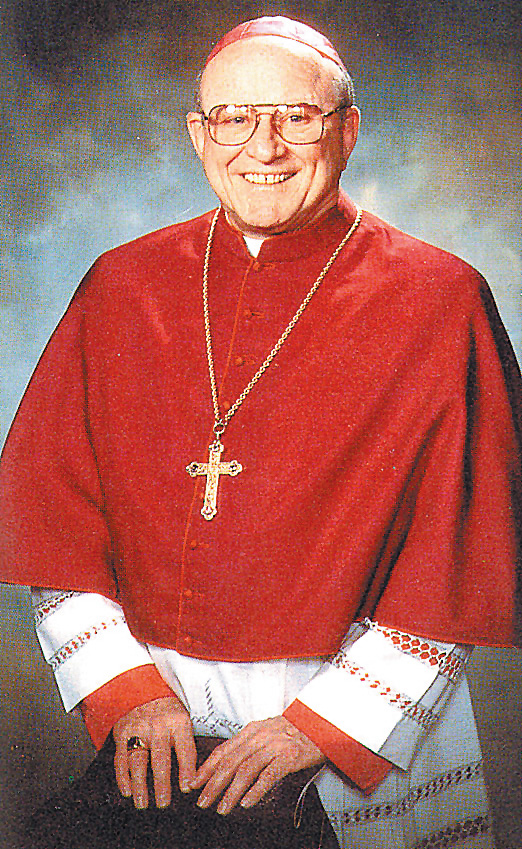
Twenty-second in a series on the 75th anniversary of the Diocese of Madison.
Bishop William H. Bullock was named the third Bishop of the Diocese of Madison on April 13, 1993, which happened to be his birthday.
“To be appointed here at age 66, and on my birthday, filled me with an eager but anxious heart,” he said. “My age and a whole new beginning in a diocese three times the size I was leaving was a big challenge.
“I never refused an assignment, nor did I intend to say no to this one, but I did remind the Office of the Nunciature of my age and I heard a delightful reply, ‘Pope Paul VI was 66 when he became Pope and John XXIII was 76. Do you think you can handle Madison?’”
Bishop Bullock accepted the challenge and was installed as Bishop of Madison on June 15, 1993. Bishop Bullock’s episcopal motto was “Grace, Mercy, and Peace,” taken from St. Paul’s letter to Timothy (Tim 1:2).
Bishop Bullock’s background
Bishop Bullock was born April 13, 1927, to Loren and Anne Bullock on a farm near Maple Lake, Minn., which had been in the Bullock family since President Ulysses S. Grant deeded the land to them in 1876. He was one of six children.
Family, hard work, and farm life formed Bishop Bullock’s roots.
He felt called to the priesthood during high school and upon graduation from Annandale High School in Annandale, Minn., he planned to follow his brothers to St. Thomas College in St. Paul. However, World War II interrupted his plans, and he joined the Navy, where he served his country until 1945.
With the help of the GI Bill, he was able to attend the University of Notre Dame, where he earned a Bachelor of Arts Degree in philosophy.
He went on to attend St. Paul Seminary and was ordained to the priesthood on June 7, 1952, at St. Paul Cathedral.
After ordination
Father Bullock was an associate pastor at three parishes in Minneapolis and Edina from 1952 to 1957.
From 1957 to 1967, he served as dean of resident cadets, religion instructor, and chairman of the religious education department at St. Thomas Academy in St. Paul, Minn.
He became headmaster in 1968 when the all-boys high school moved to Mendota Heights, Minn.
During his time at the academy, he received a Master of Arts Degree in liturgy and religious education from Notre Dame in 1962 and a doctorate in education and administration from St. Thomas University in 1969.
After 14 years at the academy, he served as pastor at St. John the Baptist Parish in Excelsior, Minn., for nine years.
While pastor there, he celebrated his 25th anniversary as a priest.
He was named Auxiliary Bishop of St. Paul and Minneapolis on June 3, 1980.
He then became pastor of Our Lady of Perpetual Help Parish in Minneapolis. He was named Bishop of the Diocese of Des Moines, Iowa, in 1987, where he served until he was named Bishop of Madison in 1993.
Three-fold agenda
Bishop Bullock had a three-fold agenda as Bishop of Madison: To encourage the spirituality of people and priests; to evaluate ways to efficiently use buildings, programs, and agencies; and to build a vision for the diocese together.
The Presbyteral Council, formerly called the Council of Priests, advised Bishop Bullock.
He also established a central Corporate Board to guide, counsel, advise, and assist the bishop regarding agencies, programs, institutions, and financial matters.
To assist Bishop Bullock in administering the diocese, Fr. Paul Swain, who had been the bishop’s secretary, was named vice chancellor and later moderator of the Curia.
In 1996, he was named vicar general to serve as the chief executive officer to the bishop for administrative matters.
Bishop Bullock put a high priority on communications. He wrote a weekly column in the Catholic Herald, the diocesan newspaper which had been renamed in 1982 from the former name Catholic Herald Citizen, and he used the paper as a tool of evangelization.
He also made regular visits to parishes to offer Mass and become acquainted with the people.
ln his first four years in Madison, Bishop Bullock visited all but two of the diocese’s 137 parishes.
Under his leadership, the diocesan Office for Justice and Peace was established, and full-time lay directors were appointed for that office as well as the Offices of Worship, Finance, and Tribunal.
Sources: Building Our Future in Faith: Commemorative History of the Catholic Diocese of Madison (1996); archives of the Catholic Herald newspaper.
Mary C. Uhler served on the staff of the Catholic Herald-Diocese of Madison for almost 47 years, the last 34 years as editor. She retired in July of 2020.

